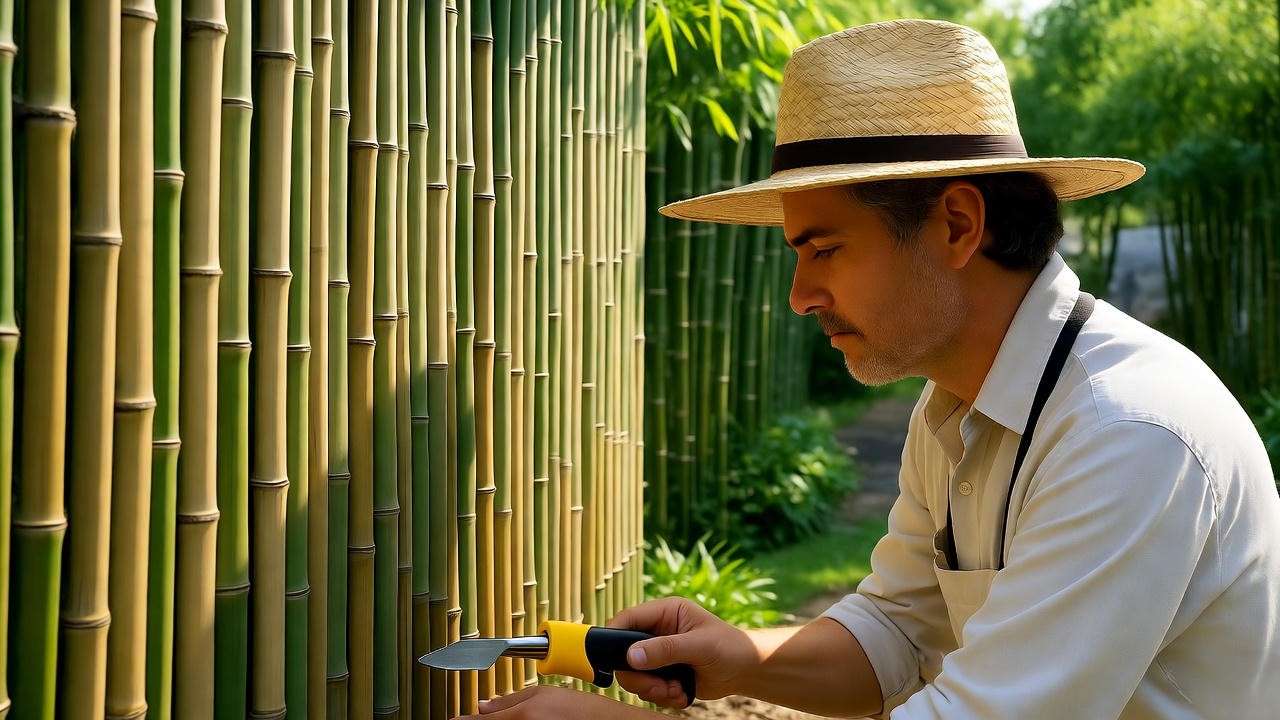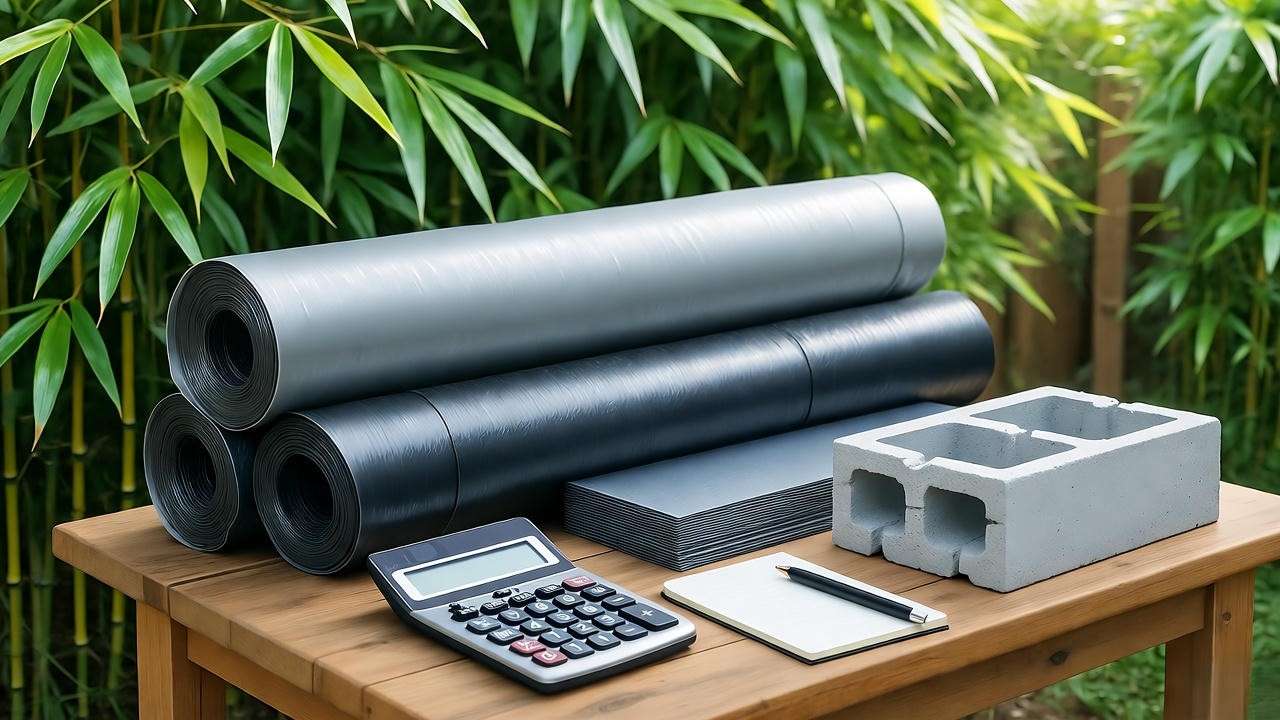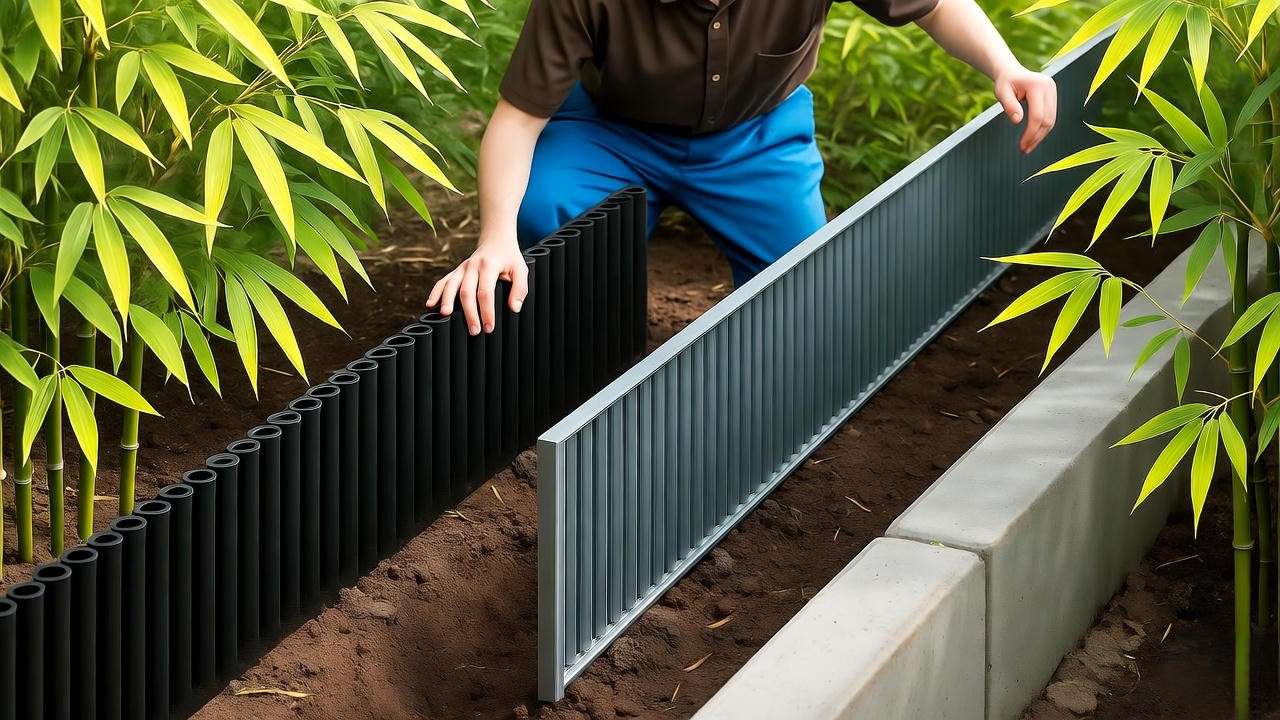Imagine waking up to find your neighbor’s bamboo creeping into your garden, its roots threatening your carefully curated flower beds and even your home’s foundation. This isn’t just a nightmare scenario—it’s a reality for many homeowners dealing with invasive bamboo. Planting a bamboo barrier is the most effective way to stop those aggressive rhizomes in their tracks, protecting your property and peace of mind. As a horticulturist with over 20 years of experience in plant care, I’ve seen firsthand how a well-installed barrier can transform a chaotic bamboo situation into a controlled, beautiful garden feature. In this comprehensive guide, you’ll learn everything you need to know about planting bamboo barriers, from choosing the right materials to avoiding common pitfalls, ensuring your garden stays safe and stunning. 🌼
This article draws on insights from certified arborists, landscape designers, and my own extensive fieldwork to deliver a step-by-step, foolproof plan. Whether you’re a seasoned gardener or a beginner, this guide will empower you to tackle bamboo’s invasive nature with confidence. Let’s dive in! 🌳
1. Understanding Bamboo’s Invasive Nature 🌾
1.1 What Makes Bamboo Invasive? 🤔
Bamboo is beloved for its lush, tropical aesthetic and fast growth, but not all bamboo behaves the same. There are two main types: running bamboo and clumping bamboo. Running bamboo, such as Phyllostachys species, is the primary culprit behind invasive growth. Its underground stems, called rhizomes, can spread up to 3–5 feet per year, sending up new shoots far from the original plant. These rhizomes are tough, capable of pushing through soil, cracking pavement, and even damaging underground pipes.
Clumping bamboo, like Fargesia species, grows more slowly, forming tight clusters without aggressive spreading. However, most bamboo-related complaints stem from running varieties, which can invade neighboring properties, disrupt ecosystems, and create costly headaches. For example, a single unchecked bamboo plant can spread over 20 feet in just a few years, making containment essential.

1.2 Why You Need a Bamboo Barrier 🚧
Without a barrier, running bamboo can wreak havoc. Its rhizomes can damage foundations, invade septic systems, and spark disputes with neighbors. A properly installed bamboo barrier acts as a physical shield, redirecting rhizomes upward or containing them within a designated area. Benefits include:
- Property Protection: Safeguard your home, garden, and infrastructure.
- Eco-Friendly Control: Avoid chemical herbicides by using a mechanical solution.
- Aesthetic Preservation: Keep bamboo as a stunning feature without letting it take over.
Expert Insight: Dr. Linda Chen, a botanist specializing in invasive species, notes, “Running bamboo rhizomes can grow up to 3 feet annually under optimal conditions. A barrier is often the only practical way to manage their spread without constant maintenance.”
2. Types of Bamboo Barriers: Choosing the Right One 🛠️
Selecting the right barrier material is critical for long-term success. Here’s a breakdown of the most effective options, along with their pros, cons, and ideal use cases.
2.1 Material Options for Bamboo Barriers 🪵
High-Density Polyethylene (HDPE)
- Pros: Flexible, durable (lasts 20+ years), easy to install, and resistant to rhizome penetration.
- Cons: Higher upfront cost (approximately $5–$10 per linear foot).
- Best For: Most residential gardens and medium-sized bamboo groves.
- Note: Look for UV-resistant HDPE to ensure longevity in sunny climates.
Metal Barriers
- Pros: Extremely durable (30+ years), nearly impenetrable by rhizomes.
- Cons: Expensive, difficult to install, and prone to rust if not stainless steel.
- Best For: Large properties or areas with highly aggressive bamboo species.
Concrete Barriers
- Pros: Permanent solution, ideal for urban settings or near structures.
- Cons: Costly (up to $20 per linear foot), labor-intensive, and less eco-friendly.
- Best For: Permanent installations where aesthetics are less critical.
Natural Alternatives
- Options: Deep trenching (regularly maintained) or root pruning.
- Pros: Low cost, eco-friendly, and suitable for small-scale bamboo control.
- Cons: Labor-intensive and less reliable than physical barriers.
- Best For: Budget-conscious gardeners willing to invest time in upkeep.
| Material | Cost (per linear foot) | Durability | Ease of Installation | Best Use Case |
|---|---|---|---|---|
| HDPE | $5–$10 | 20+ years | Easy | Residential gardens |
| Metal | $10–$15 | 30+ years | Moderate | Large properties |
| Concrete | $15–$20 | Permanent | Difficult | Urban settings |
| Natural | $0–$2 | Varies | Labor-intensive | Small-scale control |
2.2 Thickness and Depth Requirements 📏
For most running bamboo species, a barrier should be:
- Thickness: 60–80 mil (1.5–2 mm) for HDPE or metal to withstand rhizome pressure.
- Depth: 24–30 inches to block deep-running rhizomes, with 2–3 inches above ground to prevent “jumping.”
- Width: Ensure the barrier encircles the bamboo completely or extends at least 10 feet beyond the plant’s perimeter.
Tip: In colder climates, shallower barriers (18–24 inches) may suffice for less aggressive species, but always consult a local expert to confirm.
3. Step-by-Step Guide to Planting Bamboo Barrier 🌳
Installing a bamboo barrier is a straightforward but precise process. Follow these steps to ensure a rhizome-proof setup.
3.1 Planning Your Bamboo Barrier Installation 📝
Before digging, take time to plan:
- Identify Your Bamboo: Confirm whether you have running or clumping bamboo. If unsure, consult a local nursery or extension service.
- Map the Perimeter: Sketch the area where the barrier will go, ensuring it encircles the bamboo or blocks its path toward vulnerable areas (e.g., property lines).
- Check Regulations: Some municipalities or HOAs require permits for underground installations. Verify local rules to avoid fines.
- Timing: Spring or fall is ideal, as bamboo growth slows, making rhizomes easier to manage.
Visual Aid: Include a diagram showing a circular or linear barrier layout around a bamboo grove.
3.2 Tools and Materials Needed 🧰
- Tools: Shovel, trenching spade, measuring tape, utility knife, level, and tamper.
- Materials: HDPE or metal barrier, sealant (for joints), stainless steel clamps, gravel, and topsoil.
- Optional: Trencher (rent for $50–$100/day) for large projects.
Pro Tip: A trencher can cut installation time in half for projects over 50 feet. Check with your local hardware store for rentals.
3.3 Installation Process: A Foolproof Approach 🔨
Follow these steps for a secure, long-lasting barrier:
- Dig the Trench:
- Depth: 24–30 inches.
- Width: 4–6 inches to accommodate the barrier.
- Angle: Slope the trench slightly outward (5–10 degrees) to guide rhizomes upward.
- Prepare the Barrier:
- Cut HDPE or metal to size, ensuring no sharp edges.
- Clean the material to remove dirt or oils that could weaken sealant.
- Install the Barrier:
- Place the barrier in the trench, ensuring 2–3 inches remain above ground.
- Overlap joints by 6 inches and seal with waterproof tape or clamps.
- Secure the Barrier:
- Use stakes or gravel to hold the barrier in place.
- Check for gaps where rhizomes could slip through.
- Backfill and Compact:
- Fill the trench with soil, compacting every 6 inches to prevent settling.
- Add a layer of mulch or gravel on top for aesthetics.
Visual Aid: Embed a step-by-step infographic or link to a video tutorial for clarity.

3.4 Common Mistakes to Avoid 🚫
- Incorrect Depth: Too shallow (under 18 inches) allows rhizomes to sneak underneath.
- Poor Sealing: Unsealed joints are entry points for rhizomes.
- Wrong Material: Thin plastic (e.g., 30 mil) will crack under pressure.
- Bad Timing: Installing during peak growth (summer) makes rhizome control harder.
Expert Tip: Sarah Thompson, a landscape designer with 15 years of experience, advises, “Always double-check your barrier’s seal. A single gap can undo years of containment efforts.”
4. Maintaining Your Bamboo Barrier for Long-Term Success 🌞
A bamboo barrier isn’t a “set it and forget it” solution. Regular maintenance ensures it remains effective.
4.1 Regular Inspections 🔍
- Frequency: Inspect every 6 months, ideally in spring and fall.
- What to Check:
- Rhizome breaches (shoots pushing against or under the barrier).
- Barrier integrity (cracks, warping, or UV damage).
- Above-ground exposure (ensure 2–3 inches remain visible).
- Action: Trim any escaping rhizomes with a sharp spade and repair damaged sections immediately.

4.2 Complementary Strategies 🌼
Pair your barrier with these methods for enhanced control:
- Root Pruning: Cut rhizomes annually outside the barrier to weaken the plant’s spread.
- Mulching: Apply a 2–3 inch layer of mulch to suppress new shoots.
- Companion Planting: Use dense-rooted plants like comfrey or hostas to compete with bamboo.
Expert Quote: Landscape designer Mark Rivera says, “Combining a barrier with regular pruning can reduce maintenance by up to 50%, letting you enjoy bamboo’s beauty without the stress.”
4.3 When to Replace or Upgrade Your Barrier 🔄
- Signs of Wear: Cracks, warping, or thinning in HDPE; rust in metal.
- Replacement Timeline: HDPE lasts 20–30 years, metal 30–50 years, concrete indefinitely.
- Upgrading: If rhizomes breach frequently, consider a thicker material or deeper installation.
Tip: Keep a small section of spare barrier material for quick repairs.
5. Environmental and Legal Considerations 🌍
5.1 Eco-Friendly Bamboo Control 🌿
Planting a bamboo barrier is not only effective but can also be an environmentally responsible choice when done thoughtfully. Bamboo is a sustainable plant, often praised for its rapid growth and carbon-sequestering abilities. However, its invasive nature can disrupt local ecosystems if left unchecked. Here’s how to ensure your barrier installation aligns with eco-friendly practices:
- Choose Sustainable Materials: Opt for recycled HDPE or reclaimed metal barriers to reduce environmental impact. Many suppliers now offer eco-certified options that maintain durability while minimizing waste.
- Minimize Soil Disturbance: Digging a trench can disrupt soil microbiology. Use a narrow trencher to limit the footprint and avoid over-excavating. After installation, replenish the soil with organic compost to restore nutrients.
- Avoid Chemicals: A physical barrier eliminates the need for herbicides, which can harm pollinators and groundwater. If rhizome removal is necessary, use manual methods like digging or cutting.
- Support Biodiversity: Pair your barrier with native plants to enhance local ecosystems. For example, planting pollinator-friendly species like lavender or bee balm near the barrier can attract beneficial insects.
Eco Tip: Consider donating excess bamboo shoots to local artisans or community gardens, where they can be repurposed for crafts or stakes, reducing waste.
5.2 Legal and Neighborly Concerns ⚖️
Bamboo’s ability to cross property lines can lead to legal and social challenges. Addressing these proactively ensures a smooth installation process and maintains good relationships with neighbors.
- Check Local Regulations: Some municipalities classify running bamboo as an invasive species and may require permits for planting or containment. For example, certain U.S. states like New York and Connecticut have specific bamboo control laws. Contact your local zoning board or extension service to verify requirements.
- Property Line Disputes: Bamboo spreading into a neighbor’s yard can lead to conflicts. Before installing a barrier, discuss your plans with adjacent property owners. Transparency can prevent misunderstandings and even encourage cost-sharing for barrier materials.
- Documentation: Keep records of your barrier installation, including photos and receipts, in case of future disputes. This demonstrates due diligence and compliance with local laws.
Case Study: In 2023, a homeowner in Portland, Oregon, faced a neighbor’s complaint about invasive bamboo. By installing an HDPE barrier along the shared property line and sharing the costs, both parties resolved the issue amicably, with the barrier fully containing the bamboo within six months.
6. Cost Breakdown and Budgeting for Bamboo Barriers 💰
Installing a bamboo barrier is an investment in your property’s long-term health. Costs vary based on material, project size, and whether you opt for DIY or professional installation. Here’s a detailed breakdown to help you plan your budget.
| Component | DIY Cost | Professional Cost | Notes |
|---|---|---|---|
| HDPE Barrier | $5–$10/linear foot | $8–$15/linear foot | 60–80 mil thickness recommended. |
| Metal Barrier | $10–$15/linear foot | $12–$20/linear foot | Stainless steel is pricier but rust-resistant. |
| Concrete Barrier | $15–$20/linear foot | $20–$30/linear foot | Best for permanent installations. |
| Tools (Shovel, Trencher) | $50–$100 (rental) | Included in labor | Renting a trencher saves time for large projects. |
| Labor | $0 (DIY) | $20–$50/hour | 10–20 hours for a 50-foot barrier. |
| Additional Materials (Sealant, Stakes) | $50–$100 | $100–$200 | Gravel or mulch adds aesthetic value. |
- DIY Total (50-foot barrier, HDPE): $300–$600
- Professional Total (50-foot barrier, HDPE): $800–$1,200
- Savings Tip: Buy barrier materials in bulk for larger projects, and check local landscaping suppliers for discounts on recycled HDPE.

Budget Hack: If professional installation is out of reach, team up with neighbors to share tool rental costs or hire a landscaper for a group project, reducing per-person expenses.
7. FAQs: Your Bamboo Barrier Questions Answered ❓
Q1: How deep should a bamboo barrier be?
A: A depth of 24–30 inches is ideal for most running bamboo species. Ensure 2–3 inches remain above ground to prevent rhizomes from “jumping” over the barrier.
Q2: Can I install a barrier around existing bamboo?
A: Yes, but it’s more challenging. Dig carefully to avoid damaging rhizomes, and prune any existing roots outside the barrier’s perimeter to limit regrowth.
Q3: How long do bamboo barriers last?
A: HDPE barriers last 20–30 years, metal 30–50 years, and concrete barriers are permanent. Regular inspections extend their lifespan.
Q4: Are there alternatives to physical barriers?
A: Yes, regular root pruning or deep trenching can work for small-scale bamboo, but they require ongoing maintenance and are less reliable than barriers.
Q5: What if my bamboo is already invasive?
A: Start by cutting back shoots and digging out excess rhizomes. Install a barrier to contain remaining roots, and monitor for new growth outside the barrier.
Note: For complex cases, consult a local arborist or invasive species specialist for tailored advice.
8. Conclusion: Take Control of Your Bamboo Today! 🌟
Planting a bamboo barrier is a game-changer for homeowners and gardeners battling invasive bamboo. By following this guide, you can protect your property, maintain good neighborly relations, and enjoy bamboo’s beauty without its chaos. From choosing the right material to mastering installation and maintenance, you now have the tools to create a rhizome-proof garden. Start planning your barrier today, and transform your outdoor space into a safe, stunning haven. 🌳
Have a bamboo barrier success story? Share it in the comments below, or explore our related articles on eco-friendly gardening and plant care for more inspiration! 🌼














